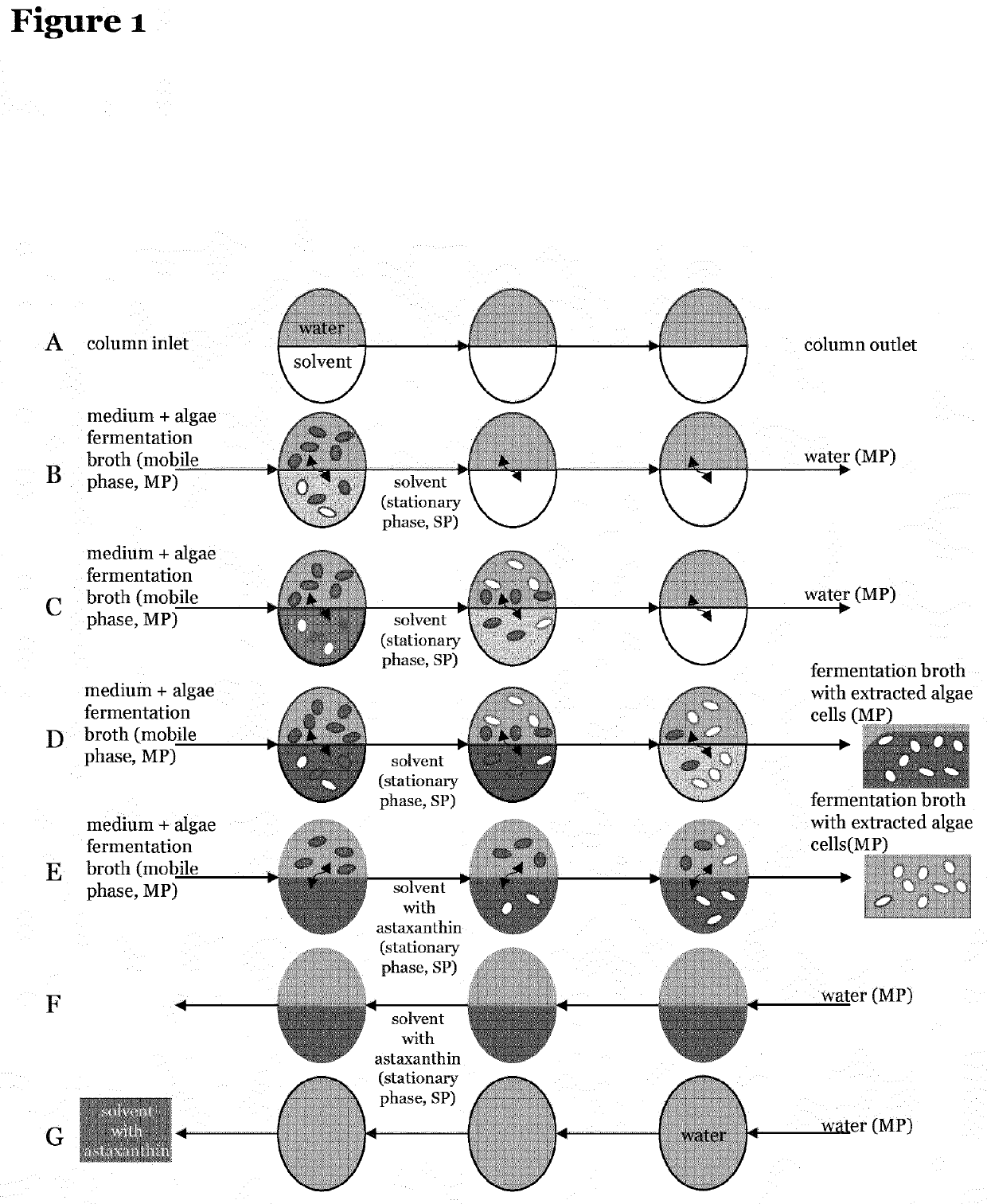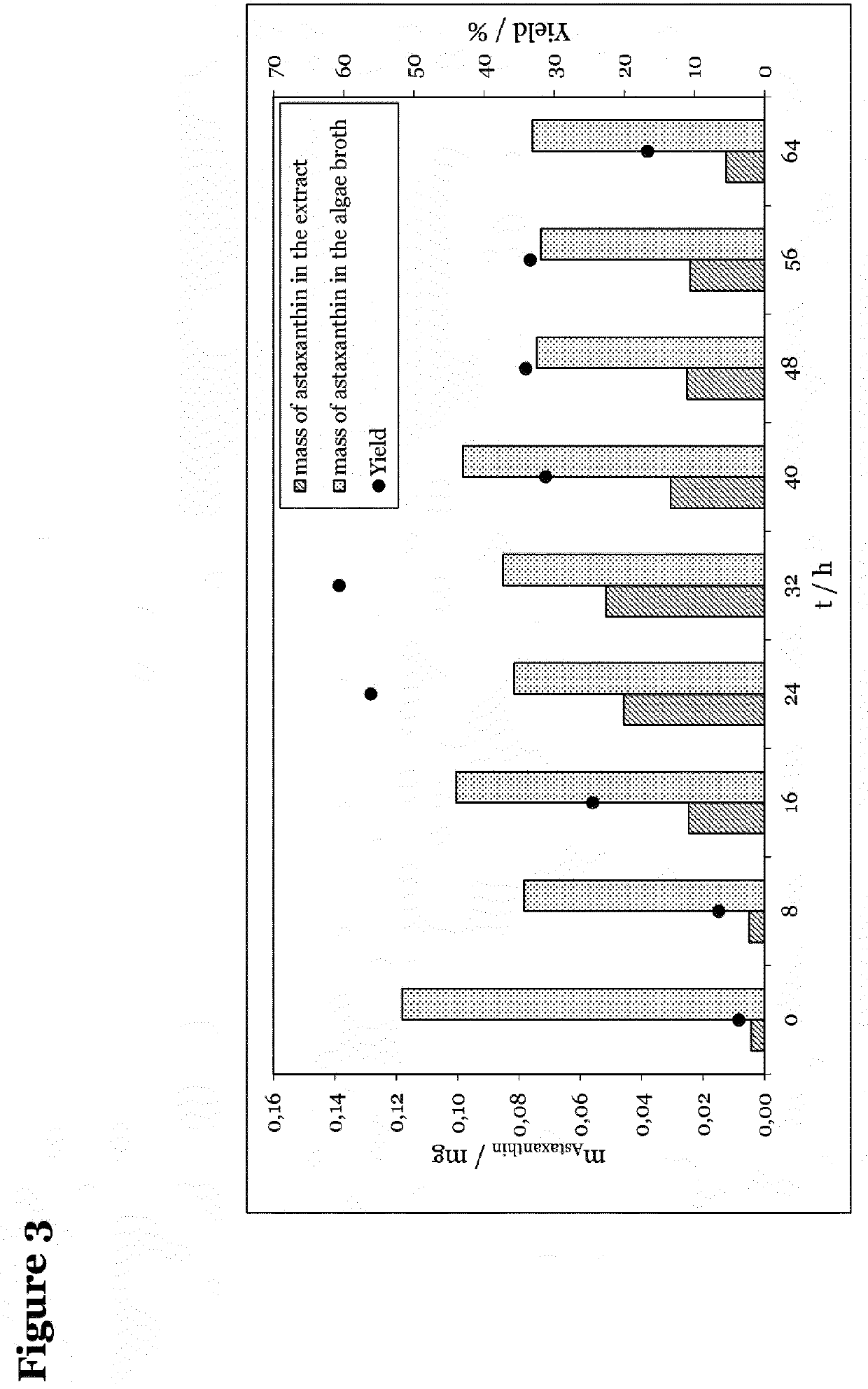Method of extracting a pigment from microalgae
a technology of microalgae and pigment, which is applied in the field of extracting pigment from microalgae, can solve the problems of high cost, inefficient process, and high cost of astaxanthin extraction from said cells having a thick cell wall, and achieves cost- and time-saving, enhanced astaxanthin extraction
- Summary
- Abstract
- Description
- Claims
- Application Information
AI Technical Summary
Benefits of technology
Problems solved by technology
Method used
Image
Examples
example 1
e Culture
[0114]Haematococcus pluvialis (SAG number 192.80) was procured from the Culture Collection of Algae at the University of Göttingen, Germany (SAG). As culture medium, Bold Modified Basal Freshwater Nutrient Solution (BBM) was used. It was prepared by diluting 20 mL Bold Modified Basal Freshwater Nutrient Solution (50× concentrate) from Sigma-Aldrich (Taufkirchen, Germany), with 980 mL de-ionized water, obtaining the following composition (per liter): 11.42 mg H3BO3, 25.0 mg CaCl2.2H2O, 0.49 mg Co(NO3)2.6H2O, 1.57 mg CuSO4.5H2O, 50.0 mg EDTA (free acid), 4.98 mg FeSO4.7H2O, 75 mg MgSO4.7H2O, 1.44 mg MnCl2.4H2O, 0.71 mg MoO3, 0.003 mg NiCl2.6H2O, 31.0 mg KOH, 0.003 mg KI, 175.0 mg KH2PO4, 75 mg K2HPO4, 25 mg NaCl, 250.0 mg NaNO3, 0.002 mg Na2SeO3, 0.001 mg SnCl4, 0.0022 mg VOSO4.3H2O, and 8.82 mg ZnSO4.7H2O. Additionally, 1.64 g of sodium acetate (Molecular biology grade, >99.0%) was added to the culture medium. The pH was adjusted to 6.8.
[0115]Parts of the H. pluvialis coloni...
example 2
of Germination
[0117]To induce germination of H. pluvialis cyst cells, 400 mL of the cyst culture broth was transferred into a 500 mL Erlenmeyer flask and placed 24 hours on the shaking plate (175 rpm) at a light intensity (photon flux density) of 50 μmol m−2 s−1 and a temperature of 24±1° C. Afterwards the broth was centrifuged at 5500 rpm for 2 min and the supernatant was discarded. The cyst biomass was suspended into fresh BBM+20 mM sodium acetate and 30 mL were transferred into a 50 mL Erlenmeyer flask with an OD of 4 at 750 nm. Culture conditions at the shaking plate were the same as described in example 1.
example 3
uitability
[0118]Relevant physical properties of several solvents are reported (Table 1). Solvents were chosen regarding their ability to extract astaxanthin from the germinated algae cells, the maximal solubility in water, their hydrophobicity and enthalpy of vaporization.
TABLE 1Physical properties of the tested solvents [6].butan-methyl-tert-ethyln-heptane1-olbutyl etheracetatedichloromethanesolubility in0.000247.44.28.081.73water / wt %(25° C.)(25° C.)(20° C.)(25° C.)(25° C.)solubility in0.0024804487.917.6water / g l−1(25° C.)(25° C.)(20° C.)(25° C.)(25° C.)log Poctanol / water / —4.50.840.940.731.25boiling point at 1 bar / ° C.98.4117.7355.077.1140enthalpy of vaporization ΔvapH,36.5752.3529.8235.6028.82(101.325 kPa, T = 25° C.) / kJ mol−1
PUM
| Property | Measurement | Unit |
|---|---|---|
| vapor pressure | aaaaa | aaaaa |
| vapor pressure | aaaaa | aaaaa |
| pressure | aaaaa | aaaaa |
Abstract
Description
Claims
Application Information
 Login to View More
Login to View More - R&D
- Intellectual Property
- Life Sciences
- Materials
- Tech Scout
- Unparalleled Data Quality
- Higher Quality Content
- 60% Fewer Hallucinations
Browse by: Latest US Patents, China's latest patents, Technical Efficacy Thesaurus, Application Domain, Technology Topic, Popular Technical Reports.
© 2025 PatSnap. All rights reserved.Legal|Privacy policy|Modern Slavery Act Transparency Statement|Sitemap|About US| Contact US: help@patsnap.com



